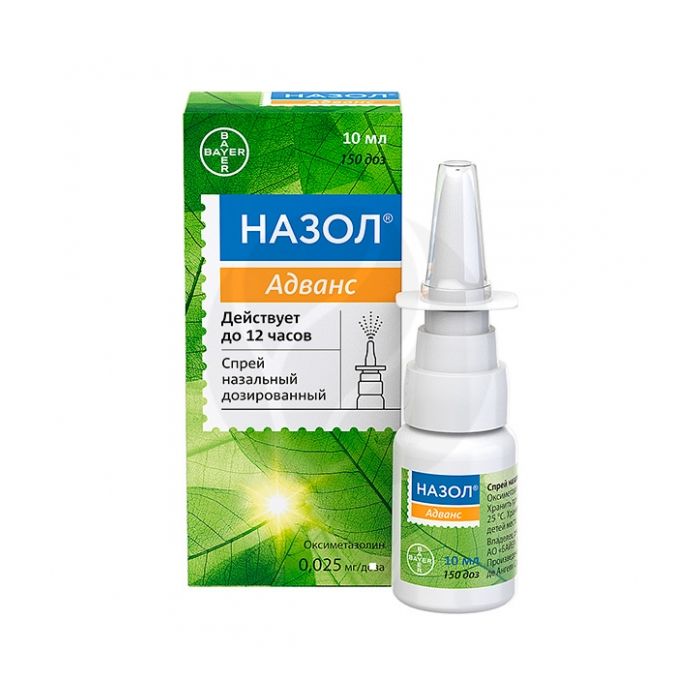Nazol Advance spray 0.025%, 10ml
Expiration Date: 05/2027
Russian Pharmacy name:
Назол Адванс спрей 0.025%, 10мл
To facilitate nasal breathing in colds and viral infections of the upper respiratory tract, sinusitis, rhinitis of any etiology.
Adults and children over 12 years old are prescribed 2-3 injections into each nasal passage 2 times / day, children aged 6 to 12 years (under the supervision of adults) - 1 injection into each nasal passage 2 times / day. Do not use the drug more than 2 times / day.
It is not recommended to use the drug for more than 3 days. With frequent or prolonged use of the drug, the feeling of difficulty in nasal breathing may reappear or worsen. If these symptoms appear, you should stop treatment and consult a doctor.
When injecting, do not tilt your head back and do not spray while lying down.
Nasal spray 0.05% in the form of a clear liquid from colorless to light yellow, with a faint smell of menthol, eucalyptus and camphor.
100 ml
oxymetazoline hydrochloride 0.05 g
Excipients: benzalkonium chloride - 0.02 g, racemic camphor - 0.17 g, eucalyptol (cineol) - 0.17 g, levomenthol - 0.17 g, disodium edetate dihydrate - 0.1 g, polysorbate 80 - 0.2 g, propylene glycol - 10 g, sodium hydrogen phosphate dihydrate - 0.006 g, sodium dihydrogen phosphate dihydrate - 0.65 g, hydrochloric acid conc. - 0.003 g, purified water - 89.711 g.
Atrophic rhinitis;
children under 6 years of age;
pregnancy;
lactation period;
hypersensitivity to the components of the drug.
The drug should be used with caution in patients with diseases of the cardiovascular system (arterial hypertension, ischemic heart disease, chronic heart failure, tachycardia, arrhythmias), impaired carbohydrate metabolism (diabetes mellitus), dysfunction of the thyroid gland (hyperthyroidism), pheochromocytoma, prostatic hyperplasia with clinical symptoms, chronic renal failure, angle-closure glaucoma, with the simultaneous use of MAO inhibitors, tricyclic antidepressants.
pharmachologic effect
A vasoconstrictor drug for local use in ENT practice. Oxymetazoline belongs to the group of alpha-adrenergic agonists for topical use. Has a vasoconstrictor effect. When administered intranasally, it reduces the swelling of the mucous membrane of the upper respiratory tract, which leads to relief of nasal breathing and the opening of the mouths of the paranasal sinuses and Eustachian tubes. The effect of the drug is manifested in 10-15 minutes after application and lasts for 10-12 hours.
Side effect
Local reactions: sometimes a burning sensation or dryness of the nasal membranes, dryness in the mouth and pharynx, sneezing, an increase in the volume of secretions released from the nose. In rare cases, after the effect of the drug has passed, a strong feeling of 'stuffiness' in the nose (reactive hyperemia). Systemic reactions: increased blood pressure, headache, dizziness, palpitations, increased anxiety, nausea, insomnia. With prolonged use of the drug (more than 7 days), reactive hyperemia of the nasal mucosa, atrophy of the nasal mucosa are possible.
Application during pregnancy and lactation
The drug is contraindicated during pregnancy and during breastfeeding.
Application for impaired renal function
The drug should be prescribed with caution in chronic renal failure.
Application in children
Contraindicated: children under 6 years of age. Children aged 6 to 12 years (under the supervision of adults) - 1 injection into each nasal passage 2 times / day.
special instructions
It is not recommended to use Nazol Advance for more than 3 days. Avoid getting the drug in the eyes. The drug has an effect on vision, a decrease in the reaction rate is possible. In order to avoid the spread of infection, it is necessary to use the drug individually.
Overdose
Symptoms: prolonged or frequent use of the drug in the nasal cavity can cause nausea, increased blood pressure, tachycardia, and central nervous system depression. Treatment: symptomatic therapy is performed.
Drug interactions
With simultaneous use with MAO inhibitors and tricyclic antidepressants, an increase in blood pressure may be observed. The drug slows down the absorption of local anesthetic drugs, lengthens their effect. The co-administration of other vasoconstrictor drugs increases the risk of side effects.

